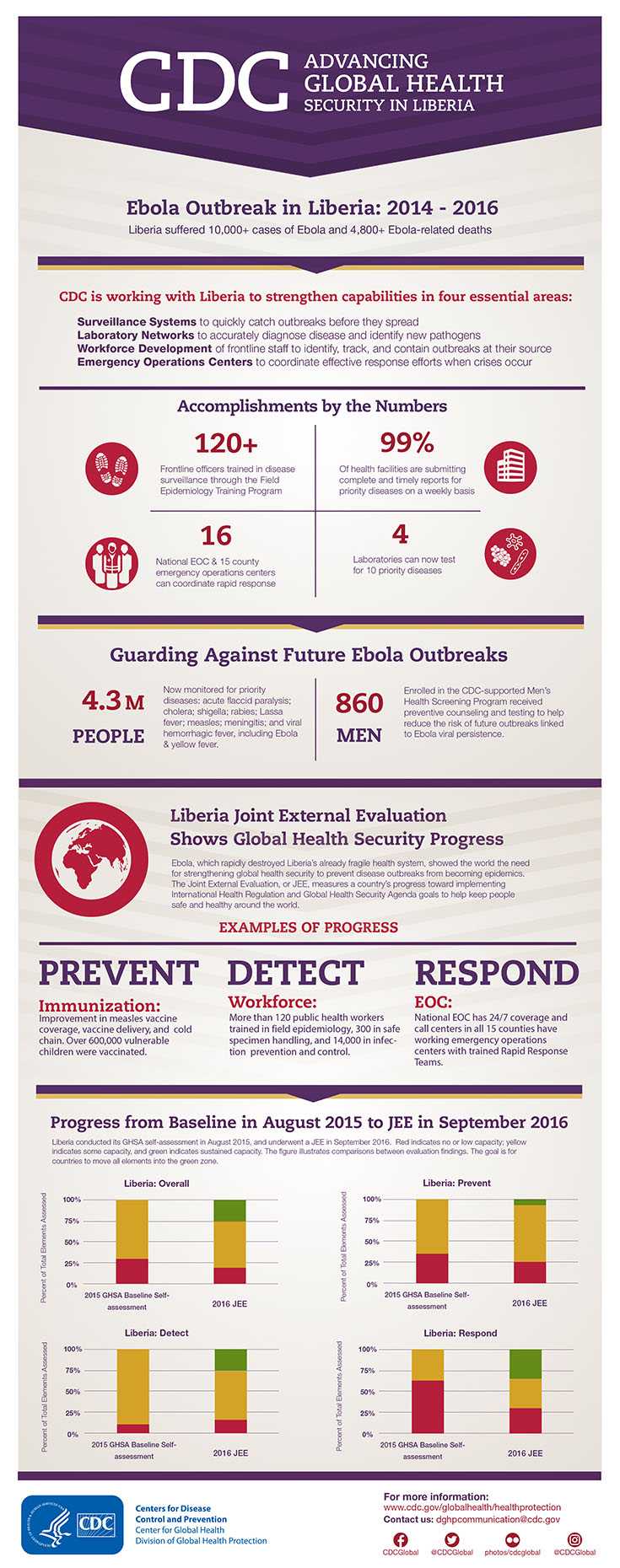Infographics: CDC Advancing Global Health Security in Liberia
Download infographic pdf [256KB]

CDC: Advancing Global Health Security in Liberia
Ebola Outbreak in Liberia: 2014-2016
Liberia suffered 10,000+ cases of Ebola and 4,800+ Ebola-related deaths
CDC is working with Liberia to strengthen capabilities in four essential areas:
Surveillance Systems to quickly catch outbreaks before they spread
Laboratory Networks to accurately diagnose disease and identify new pathogens
Workforce Development of frontline staff to identify, track, and contain outbreaks at their source
Emergency Operations Centers to coordinate effective response efforts when crises occur
Accomplishments by the Numbers
Illustration of footprints
120+ Frontline officers trained in disease surveillance through the Field Epidemiology Training Program
99% Of health facilities are submitting complete and timely reports for priority diseases on a weekly basis
Illustration of building
Illustration of first responders
16 National EOC & 15 county emergency operations centers can coordinate rapid response
4 Laboratories can now test for 10 priority diseases
Illustration of pathogens
Guarding Against Future Ebola Outbreaks
4.3M PEOPLE Now monitored for priority diseases: acute flaccid paralysis; cholera; shigella; rabies; Lassa fever; measles; meningitis; and viral hemorrhagic fever, including Ebola & yellow fever.
860 MEN Enrolled in the CDC-supported Men’s Health Screening Program received preventive counseling and testing to help reduce the risk of future outbreaks linked to Ebola viral persistence.
Illustration of globe
Liberia Joint External Evaluation Shows Global Health Security Progress
Ebola, which rapidly destroyed Liberia's already fragile health system, showed the world the need for strengthening global health secuirty to prevent disease outbreaks from becoming epidemics. The Joint External Evaluation, or JEE, measures a country's progress toward implementing International Health Regulations and Global Health Security Agenda goals to help keep people safe and healthy around the world.
Examples of Progress
PREVENT Immunization:
Improvement in measles vaccine coverage, vaccine delivery, and cold chain. Over 600,000 vulnerable children were vaccinated
DETECT Workforce:
More than 120 public health workers trained in field epidemiology, 300 in safe specimen handling, and 14,000 in infection prevention and control
EOC has 24/7 coverage and call centers in all 15 counties have working emergency operations centers with trained Rapid Response Teams
Progress from Baseline in August 2015 to JEE in September 2016
Liberia conducted its GHSA self-assessment in August 2015, and underwent a JEE in September 2016. Red indicates no or low capacity; yellow indicates some capacity, and green indicates sustained capacity. The figure indicates comparisons between evaluation findings. The goal is for countries to move all elements into the green zone.
Liberia: Overall
2015 GHSA Baseline Self-assessment: 25% red and 75% yellow
2016 JEE: 20% red; 55% yellow and 25% green
Liberia: Prevent
2015 GHSA Baseline Self-assessment: 30% red and 70% yellow
2016 JEE: 25% red; 70% yellow and 5% green
Liberia: Detect
2015 GHSA Baseline Self-assessment: 10% red and 90% yellow
2016 JEE: 15% red; 60% yellow and 25% green
Liberia: Respond
2015 GHSA Baseline Self-assessment: 60% red and 40% yellow
2016 JEE: 30% red; 35% yellow and 35% green
Illustration of HHS and CDC logos
Centers for Disease Control and Prevention
Center for Global Health
Division of Global Health Protection
For more information: www.cdc.gov/globalhealth/healthprotection
Contact us: dghpcommunication@cdc.gov
Facebook symbol @CDCGlobal
Twitter symbol @CDCGlobal
Flickr symbol photos/cdcglobal
Instagram symbol @CDCGlobal
- Page last reviewed: May 9, 2017
- Page last updated: May 9, 2017
- Content source:


 ShareCompartir
ShareCompartir